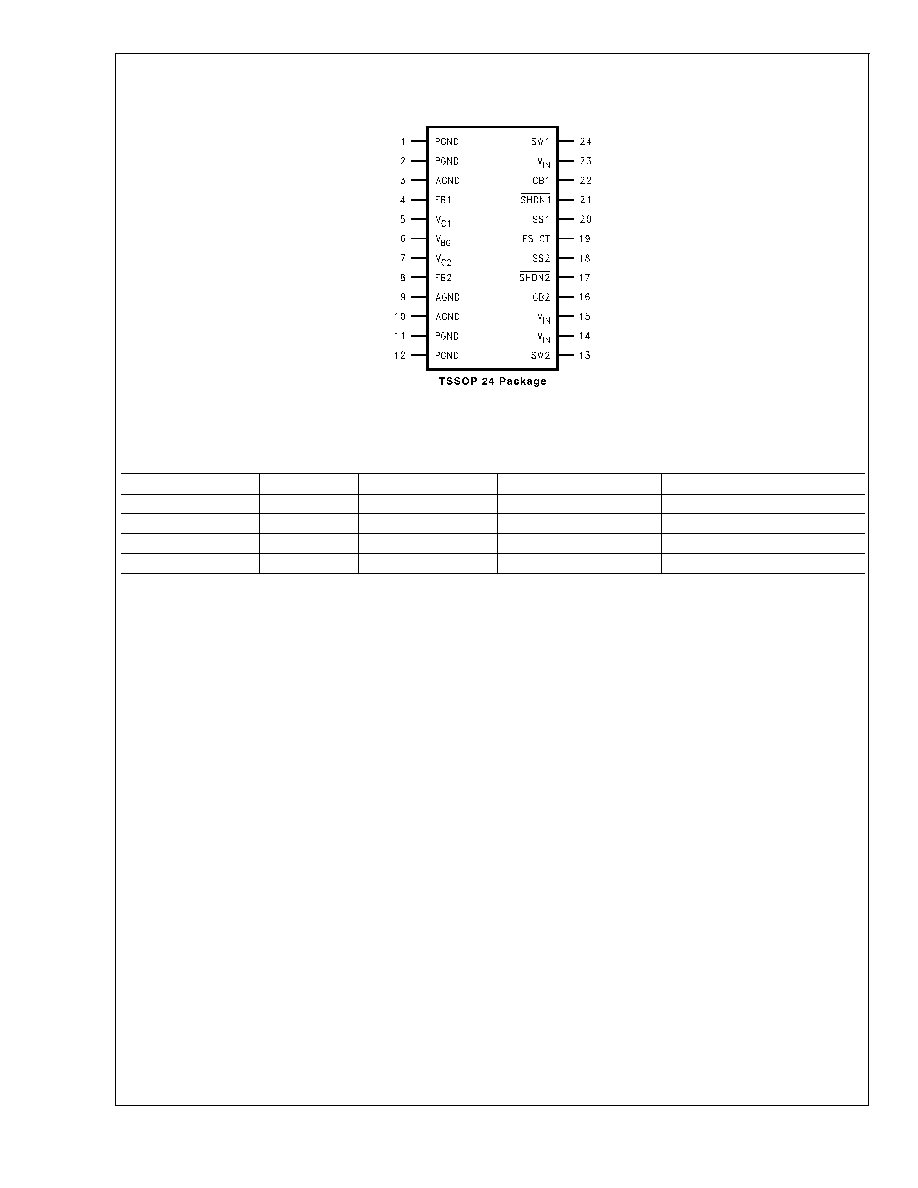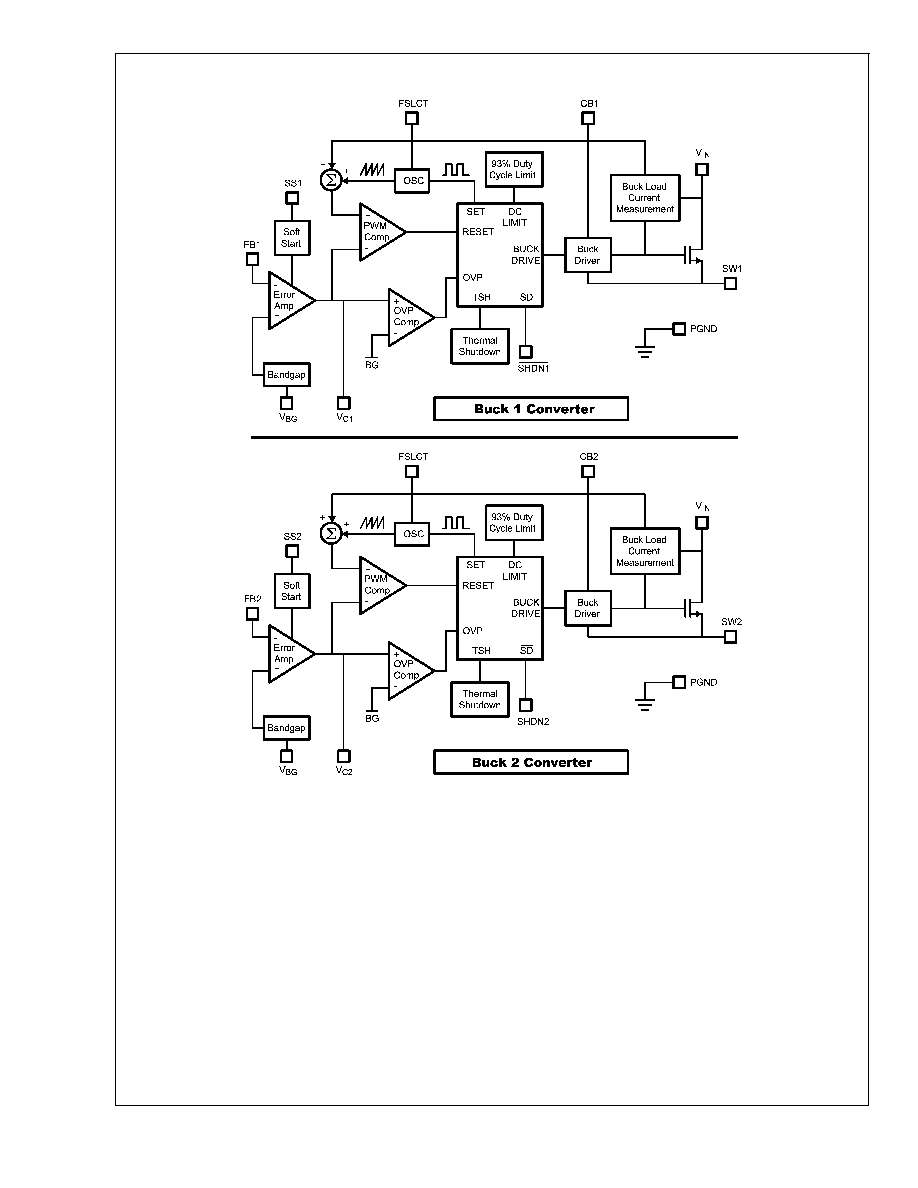
LM2717-ADJ
Dual Step-Down DC/DC Converter
General Description
The LM2717-ADJ is composed of two PWM DC/DC buck
(step-down) converters. Both converters are used to gener-
ate an adjustable output voltage as low as 1.267V. Both also
feature low R
DSON
(0.16
) internal switches for maximum
efficiency. Operating frequency can be adjusted anywhere
between 300kHz and 600kHz allowing the use of small
external components. External soft-start pins for each con-
verter enables the user to tailor the soft-start times to a
specific application. Each converter may also be shut down
independently with its own shutdown pin. The LM2717-ADJ
is available in a low profile 24-lead TSSOP package ensur-
ing a low profile overall solution.
Features
n
Adjustable buck converter with a 2.2A, 0.16
, internal
switch (Buck 1)
n
Adjustable buck converter with a 3.2A, 0.16
, internal
switch (Buck 2)
n
Operating input voltage range of 4V to 20V
n
Input undervoltage protection
n
300kHz to 600kHz pin adjustable operating frequency
n
Over temperature protection
n
Small 24-Lead TSSOP package
Applications
n
TFT-LCD Displays
n
Handheld Devices
n
Portable Applications
n
Laptop Computers
n
Automotive Applications
Typical Application Circuit
20167901
March 2006
LM2717-ADJ
Dual
Step-Down
DC/DC
Converter
© 2006 National Semiconductor Corporation
DS201679
www.national.com

Pin Descriptions
Pin
Name
Function
1
PGND
Power ground. PGND and AGND pins must be connected together directly at the part.
2
PGND
Power ground. PGND and AGND pins must be connected together directly at the part.
3
AGND
Analog ground. PGND and AGND pins must be connected together directly at the part.
4
FB1
Buck 1 output voltage feedback input.
5
V
C1
Buck 1 compensation network connection. Connected to the output of the voltage error
amplifier.
6
V
BG
Bandgap connection.
7
V
C2
Buck 2 compensation network connection. Connected to the output of the voltage error
amplifier.
8
FB2
Buck 2 output voltage feedback input.
9
AGND
Analog ground. PGND and AGND pins must be connected together directly at the part.
10
AGND
Analog ground. PGND and AGND pins must be connected together directly at the part.
11
PGND
Power ground. PGND and AGND pins must be connected together directly at the part.
12
PGND
Power ground. PGND and AGND pins must be connected together directly at the part.
13
SW2
Buck 2 power switch input. Switch connected between V
IN
pins and SW2 pin.
14
V
IN
Analog power input. All V
IN
pins are internally connected and should be connected
together directly at the part.
15
V
IN
Analog power input. All V
IN
pins are internally connected and should be connected
together directly at the part.
16
CB2
Buck 2 converter bootstrap capacitor connection.
17
SHDN2
Shutdown pin for Buck 2 converter. Active low.
18
SS2
Buck 2 soft start pin.
19
FSLCT
Switching frequency select input. Use a resistor to set the frequency anywhere between
300kHz and 600kHz.
20
SS1
Buck 1 soft start pin.
21
SHDN1
Shutdown pin for Buck 1 converter. Active low.
22
CB1
Buck 1 converter bootstrap capacitor connection.
23
V
IN
Analog power input. All V
IN
pins are internally connected and should be connected
together directly at the part.
24
SW1
Buck 1 power switch input. Switch connected between V
IN
pins and SW1 pin.
LM2717-ADJ
www.national.com
3

Absolute Maximum Ratings
(Note 1)
If Military/Aerospace specified devices are required,
please contact the National Semiconductor Sales Office/
Distributors for availability and specifications.
V
IN
-0.3V to 22V
SW1 Voltage
-0.3V to 22V
SW2 Voltage
-0.3V to 22V
FB1 Voltage
-0.3V to 7V
FB2 Voltage
-0.3V to 7V
V
C1
Voltage
1.75V
V
C1
2.25V
V
C2
Voltage
0.965V
V
C2
1.565V
SHDN1 Voltage
-0.3V to 7.5V
SHDN2 Voltage
-0.3V to 7.5V
SS1 Voltage
-0.3V to 2.1V
SS2 Voltage
-0.3V to 2.1V
FSLCT Voltage
AGND to 5V
Maximum Junction Temperature
150°C
Power Dissipation(Note 2)
Internally Limited
Lead Temperature
300°C
Vapor Phase (60 sec.)
215°C
Infrared (15 sec.)
220°C
ESD Susceptibility (Note 3)
Human Body Model
2kV
Operating Conditions
Operating Junction
Temperature Range
(Note 4)
-40°C to +125°C
Storage Temperature
-65°C to +150°C
Supply Voltage
4V to 20V
SW1 Voltage
20V
SW2 Voltage
20V
Switching Frequency
300kHz to 600kHz
Electrical Characteristics
Specifications in standard type face are for T
J
= 25°C and those with boldface type apply over the full Operating Tempera-
ture Range (T
J
= -40°C to +125°C). V
IN
= 5V, I
L
= 0A, and F
SW
= 300kHz unless otherwise specified.
Symbol
Parameter
Conditions
Min
(Note 4)
Typ
(Note 5)
Max
(Note 4)
Units
I
Q
Total Quiescent Current (both
switchers)
Not Switching
2.7
6
mA
Switching, switch open
6
12
mA
V
SHDN
= 0V
9
27
µA
V
BG
Bandgap Voltage
1.248
1.230
1.267
1.294
1.299
V
%V
BG
/
V
IN
Bandgap Voltage Line
Regulation
-0.01
0.01
0.125
%/V
V
FB1
Buck 1 Feedback Voltage
1.236
1.214
1.258
1.286
1.288
V
V
FB2
Buck 2 Feedback Voltage
1.236
1.214
1.258
1.286
1.288
V
I
CL1
(Note 6) Buck 1 Switch Current Limit
V
IN
= 8V (Note 7)
2.2
A
V
IN
= 12V, V
OUT
= 3.3V
1.4
1.65
2.0
I
CL2
(Note 6) Buck 2 Switch Current Limit
V
IN
= 8V (Note 7)
3.2
A
V
IN
= 12V, V
OUT
= 5V
2.6
3.05
3.5
I
B1
Buck 1 FB Pin Bias Current
(Note 8)
V
IN
= 20V
70
400
nA
I
B2
Buck 2 FB Pin Bias Current
(Note 8)
V
IN
= 20V
65
400
nA
V
IN
Input Voltage Range
4
20
V
g
m1
Buck 1 Error Amp
Transconductance
I = 20µA
1340
µmho
g
m2
Buck 2 Error Amp
Transconductance
I = 20µA
1360
µmho
A
V1
Buck 1 Error Amp Voltage
Gain
134
V/V
A
V2
Buck 2 Error Amp Voltage
Gain
136
V/V
D
MAX
Maximum Duty Cycle
89
93
%
LM2717-ADJ
www.national.com
5




